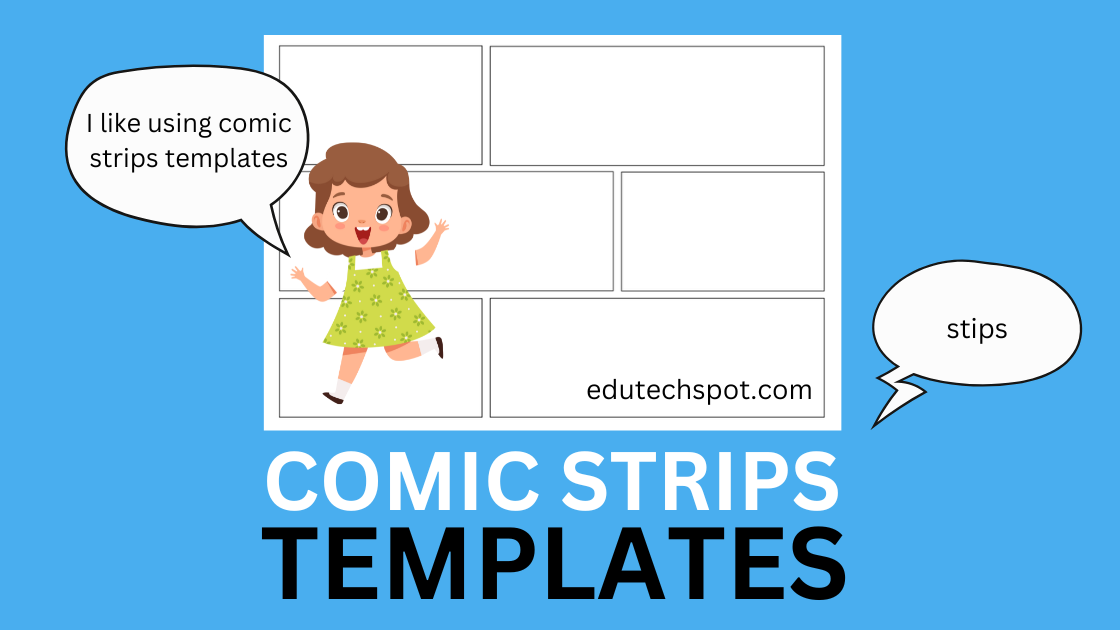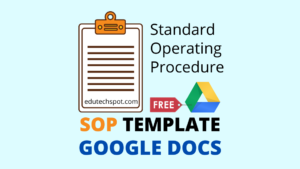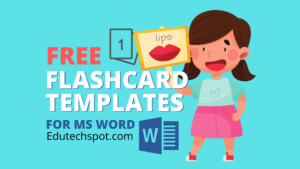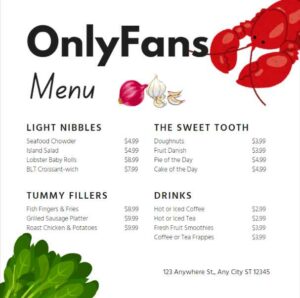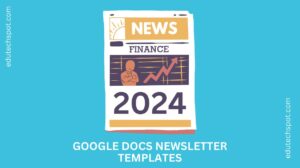Comic strips templates. Welcome to the world of comic strip creation! Whether you’re an experienced artist or a beginner, the possibilities are endless when it comes to creating your own comics. A good comic strip requires a combination of creativity, storytelling, and attention to detail. But don’t worry, with the right tools and resources, anyone can create a compelling and engaging comic. That’s why I’m here to provide you with some comic strip templates in PDF format that are ready to print and use for educational purposes. These templates will help you get started on your comic-making journey and give you a foundation to build upon. So, let’s get started!
I recommend reading: 21 Free Online Comic Strip Makers | Comic Panels | How to Make a Comic Book on the Computer | Create Digital Art | Free Flash Card Template for Word
Templates for Comic Strips
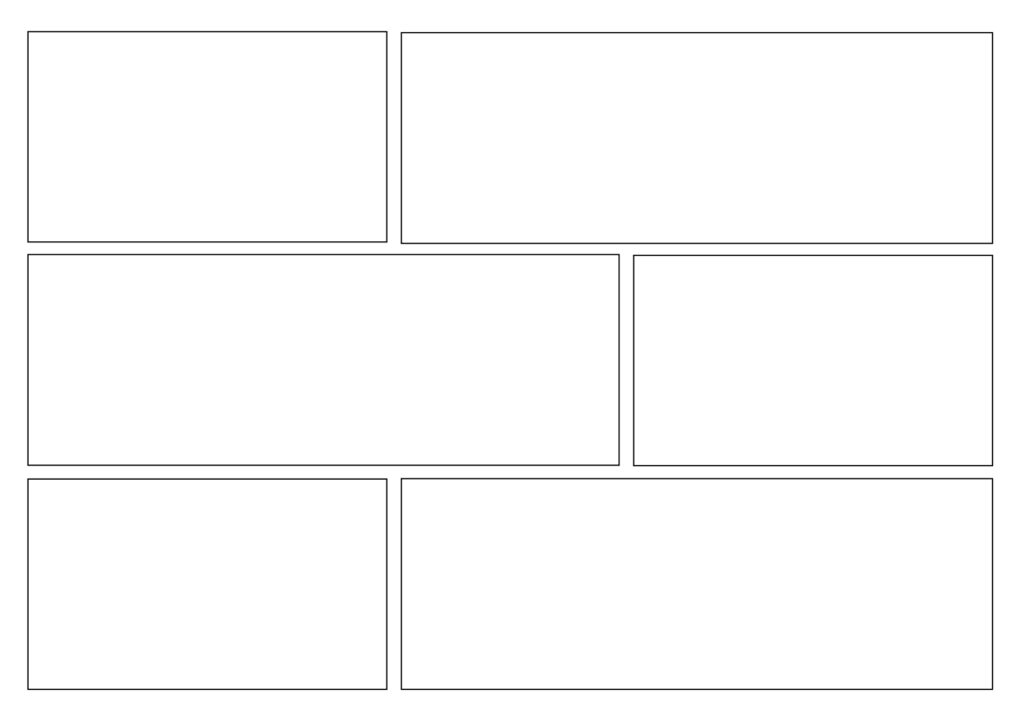
Templates for Comic Strips 1
This panel template contains 6 boxes with alternating size in each row. In general, the layout goes in two columns and three rows. The column width in each row is at alternating size. For example, in the first row, it begins with a column of about 40% width, and the right column that is the second column is at about 60% width. This width composition is then alternated in the following row, that is the second row. The last row goes back to the first composition. This allows students to figure out what kind of event they should input to each column with different width. Sometimes the smaller one can be the focus, and the wider one can be for long view.
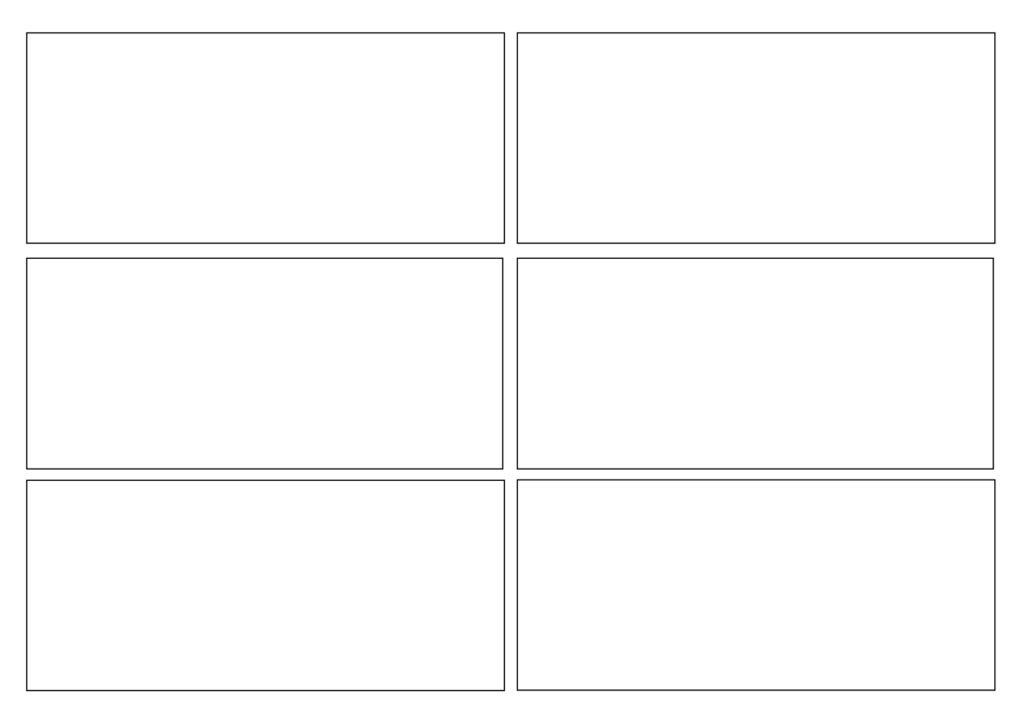
Templates for Comic Strips 2
This second comic strip template panel is arranged in the same width. meanwhile, the composition between the row and column remains the same as the previous one, that is two columns and three rows. The width of each column is the same between the left and the right, that is 50%. I think, this type of comic strip panel is suitable for beginner whose focus is on filling the panel with images and conversation or dialog bulb. The goal is just that the students feel comfortable in participating in the comic making project. As long as the students can put their ideas into the panel, it is considered achieved. Students who are beginner at this process will feel that this task is easy and thus hopefully can motivate them to do the complex ones. Using this similar size panel, they will not find it hard to think about what focus or what specific event should be put in the smaller panel or the bigger panel.
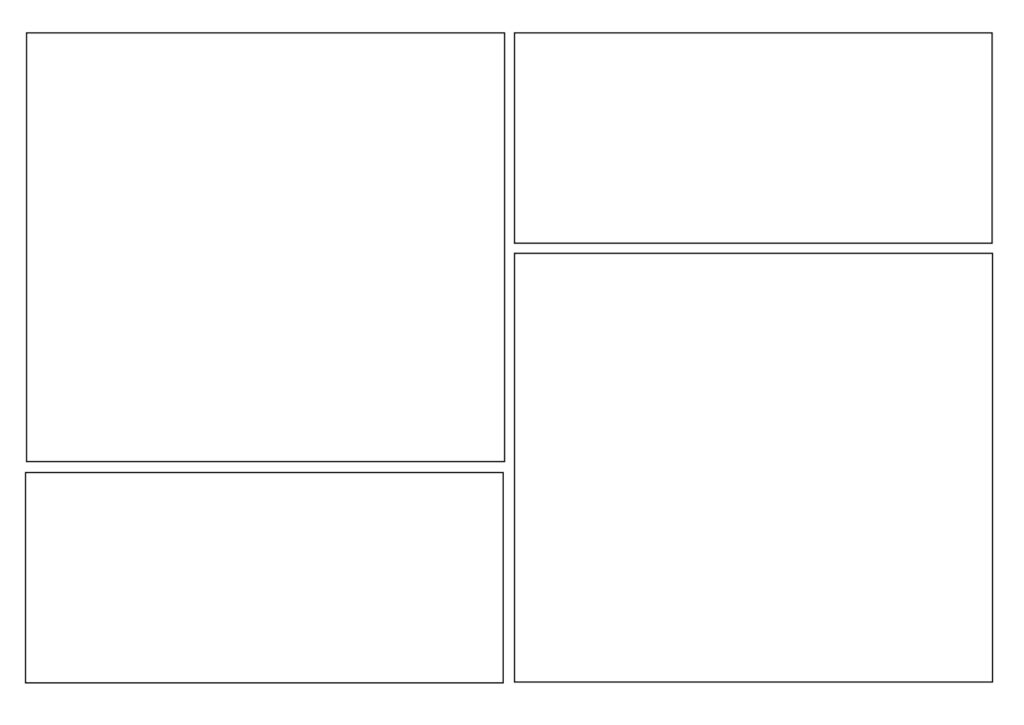
Templates for Comic Strips 3
This comic strip template layout is completely different from the previous ones. This one starts with a bigger size and is in the intersection of the two panels in the right. It feels like a photo collage and is in the masonry style.
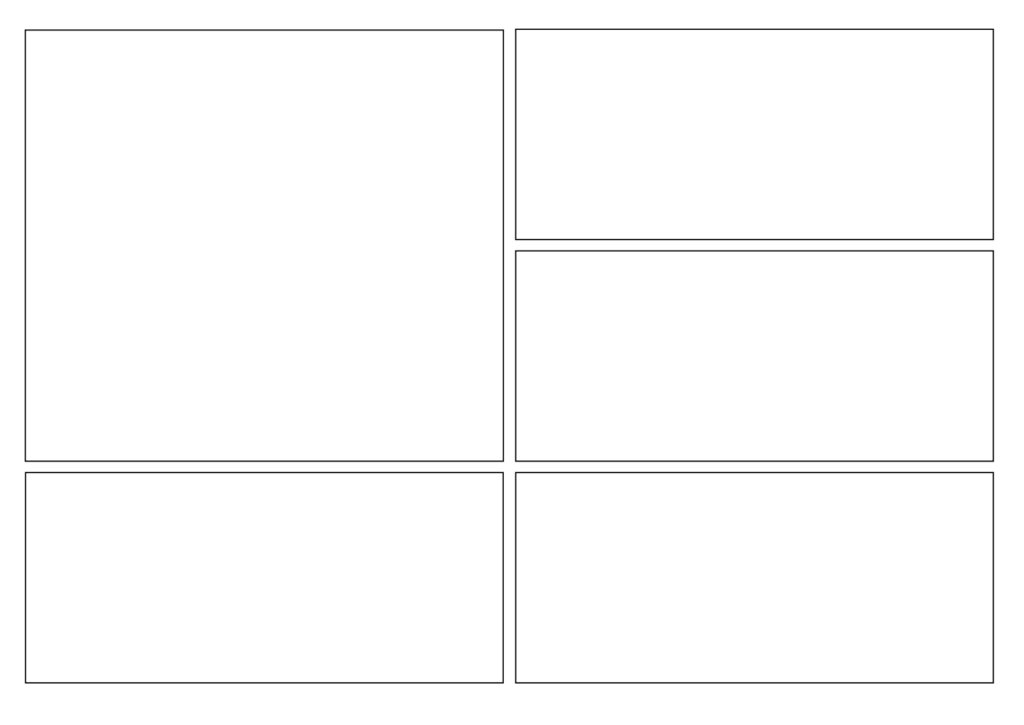
Templates for Comic Strips 4
This layout is also of unique composition. It begins with big square that is inline with two smaller grids at the same size but a half of the bigger one. The bottom part is at the same column with but with smaller height. The opening big square can be used to inform a hook, or an event that is shocking.
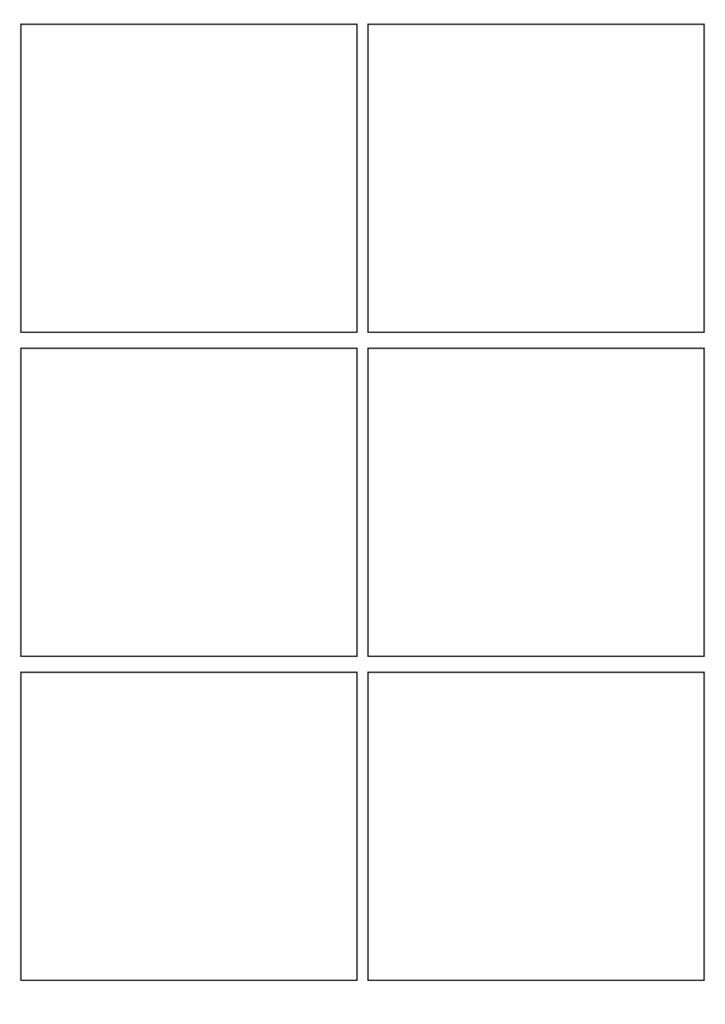
Templates for Comic Strips 5
This layout is similar to item number 2. The boxes are at the same size. There are six boxes in two columns and three rows. They are all in square shapes with the same size. This type of comic strip template is also perfect for beginners who do not have to think about which panel size should be used for which event.
I remember when I was a kid, trying to create my own comic. Initially I was struggling to follow model comic from famous comic books. However, I found it so hard to follow. Some of the panel are overlapped, some others are in triangle, and other unusual forms. Then, I tried to create my own panel, and I came up with panels with the same size. At that time, it gave me ease in drawing as all I have to do is drawing within the panel. I did not need to think hard replicating the professional and advanced unusual shape of comic panel layout.
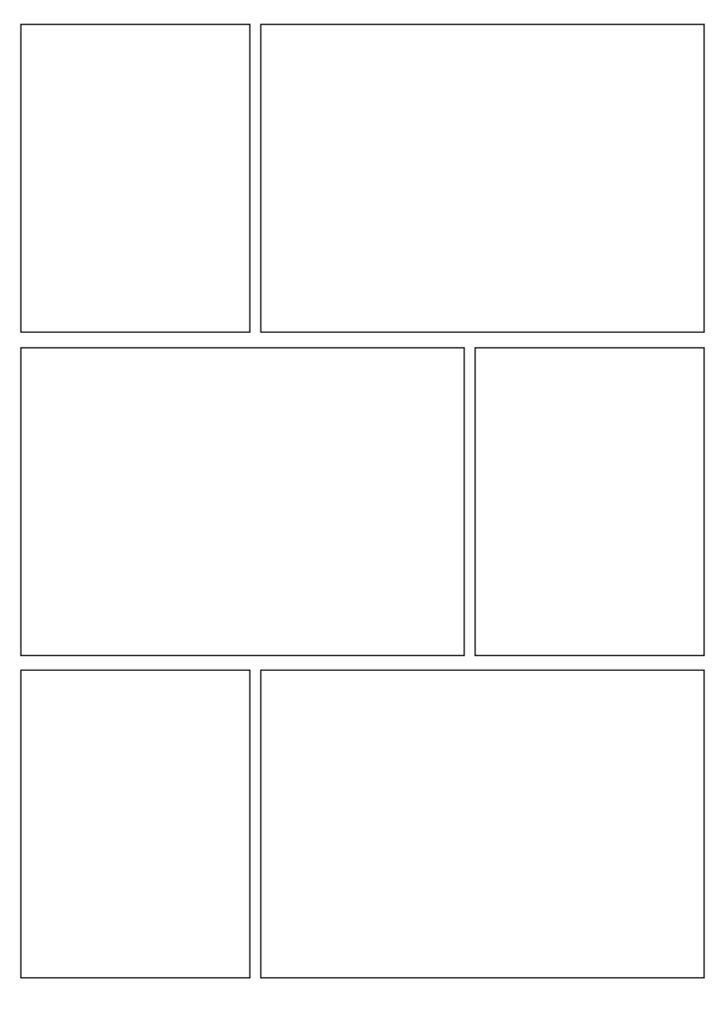
Templates for Comic Strips 6
This one is actually similar to comic strip template number 1, the first in this page. The difference is that it is in portrait while the earlier is in landscape. This is for those who have already practiced drawing comic characters into comic panels for a while. They have already had experience that is enough to go more advanced. This type of panel does require experience because the size of each box is different from one another. One is small and one other is bigger. The student, when using this template, has to adjust specific event that would match the size of the panel. For example, the smaller box can be used to position a man walking, while the right side that is bigger, is to portray when the man is walking, thus require the student to also draw the surrounding.
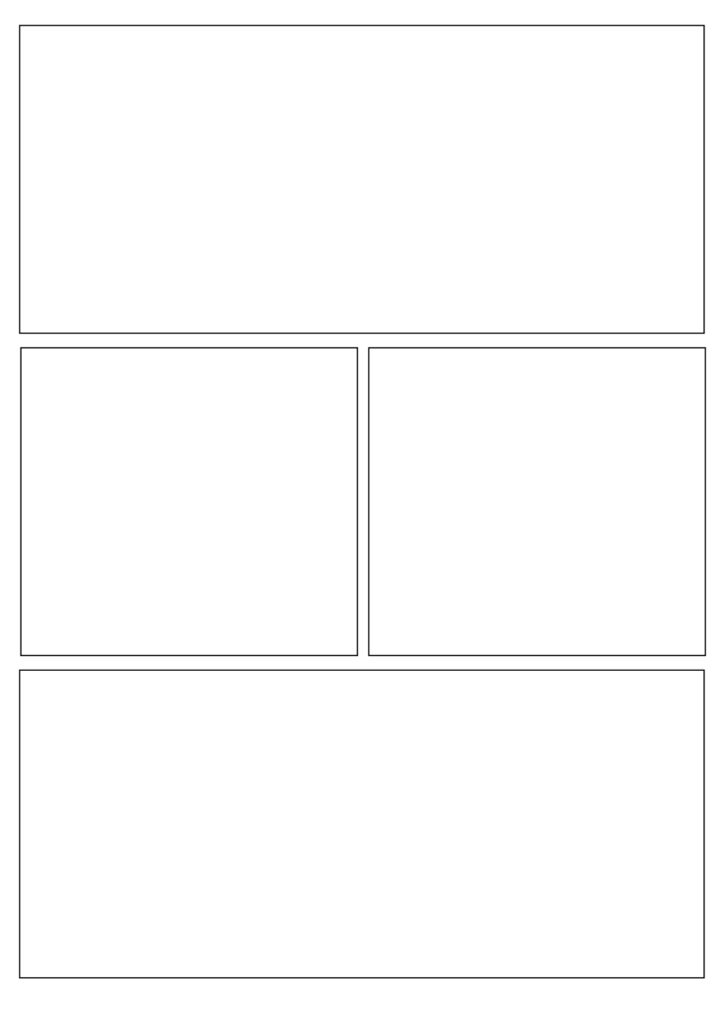
Templates for Comic Strips 7
The comic strip template that features one big panel in the first and third rows, and two equal-sized panels in the second row, is a classic layout that has been used in comics for decades. This type of panel layout is ideal for comics that require a mix of large, dramatic visuals and smaller, more focused scenes.
In the first row, the big panel can be used to showcase a wide-angle shot or a detailed close-up of the scene. This panel is perfect for introducing the setting, characters, or establishing the mood of the story. In the second row, the two equal-sized panels can be used to show two different perspectives of the same scene or to depict a sequence of actions. This layout is particularly effective for showing cause and effect, or for building tension and suspense. In the third row, the big panel can be used to create a sense of closure or to show the aftermath of the events that took place in the previous panels.
To ensure a clear reading order, it is suggested that the speech bubble or dialogue should be positioned close to the characters or objects they are referring to. In the first row, the speech bubble can be placed in the top or bottom corner of the panel, while in the second row, they can be positioned above or below each panel. In the third row, the speech bubble can be placed in the center of the panel or at the bottom, depending on the layout of the image.
This type of comic strip panel layout is suitable for a variety of events, including action scenes, suspenseful moments, and scenes that require a lot of detail. It is particularly effective for comics that want to establish a sense of place or create a cinematic feel. Overall, this classic layout is a great starting point for anyone who wants to create an engaging and visually appealing comic.
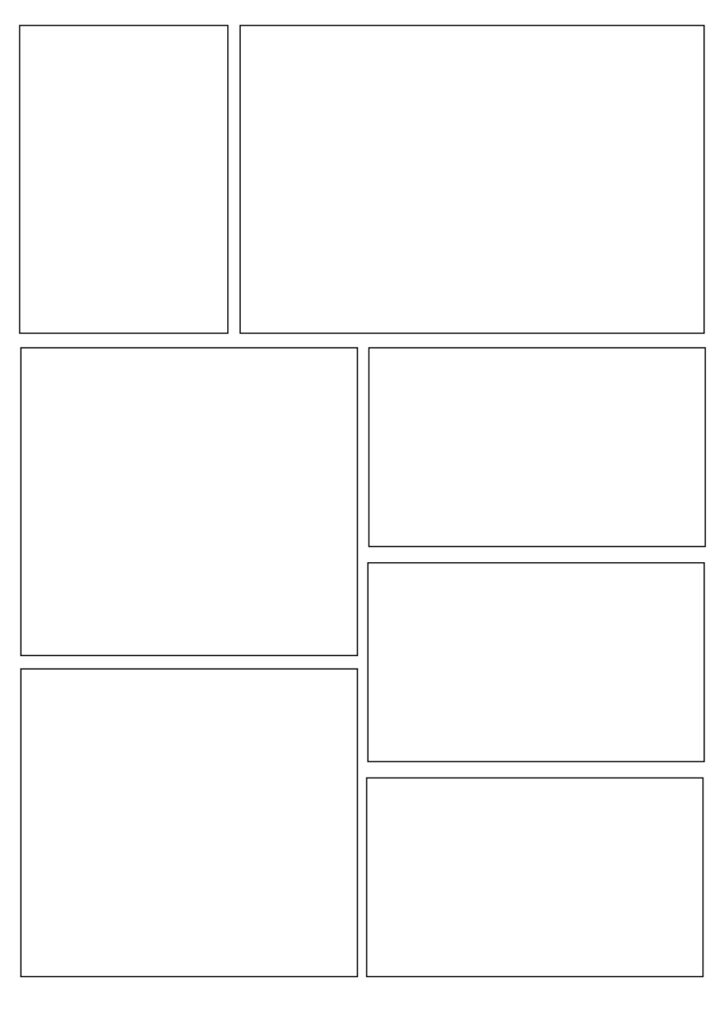
Templates for Comic Strips 8
The comic strip template with a layout featuring two boxes in the first row, a two-column layout in the second row, and a mix of squares and rectangles in each column, is a unique and versatile design that can accommodate a range of storytelling styles.
In the first row, the two boxes can be used to show different perspectives of the same scene or to juxtapose two separate events. The 30% box can be used to show a close-up detail or a smaller moment in the story, while the 70% box can be used to showcase a larger scene or a key event.
In the second row, the two columns provide ample space to create a sequence of actions or to depict multiple characters interacting with each other. The first column can be used to show two big squares, which can be used to depict key moments in the story or to focus on the emotions of the characters. The second column can be used to show three rows of rectangles, which can be used to create a sense of movement or to show a series of related events.
It is advised that speech bubbles or dialogue be positioned close to the characters or things they are referring to in order to guarantee clear communication. In the first row, for example, the speech bubble can be placed above or below each box. The speech bubbles in the second row can be positioned in the middle or near the characters or things they are referring to.
This sort of comic strip panel layout is appropriate for storylines with a lot of information or several plotlines. It’s especially useful in comics if you want to establish a feeling of development or highlight the link between different characters or events.
Comic Strip Template

Comic Strip Template 10 Pages
More collection of comic strip template. There are 10 pages in this archive.
Comic Strip Templates Free
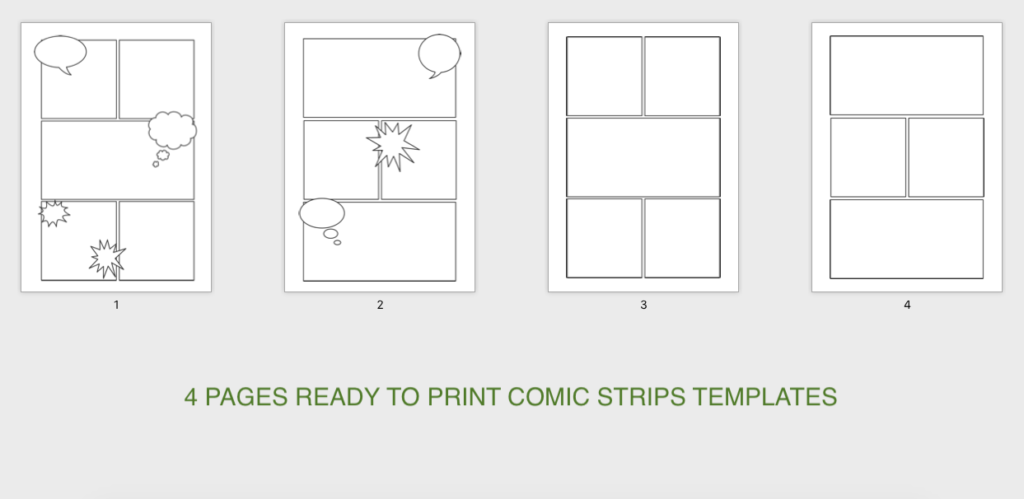
Comic Strip Templates Free 4 Pages
More collection of the templates. there are 4 pages. Two of them are with speech bubbles.
Do you know what comic strip is?
Comic strips are collections of cartoon images contained in a box that can be used to create a story.
The satire style used in newspapers and the heroic storyline used in comic books are just a few examples of the many distinct comic strip styles.
They frequently use boxes to depict new events or actions, which is a popular creative pattern. Cartoon and comic strip characters are almost usually vivid and interesting. The majority of the time, kids speak in what we refer to as “speech bubbles.”
It’s simple to communicate artistic ideas and foster creativity by creating your own comic strip using our templates. They’re a terrific method to provide kids a place to combine their writing and drawing skills.
Why not have your kid or the class try to create their own cartoon strip? It’s a terrific method to encourage creativity and help kids develop their imagination to use a template like the one offered.
My Personal Thoughts
Creating a comic strip can be a fun and engaging way to express your creativity and storytelling skills. Thanks to modern technology, there are now many tools and resources available to help you bring your comic strip ideas to life. One such resource is a comic strip generator, which allows you to quickly and easily create your own comics using pre-designed templates and tools. Whether you’re a seasoned comic creator or just starting out, a comic strip generator can be a valuable tool to have in your arsenal.
When designing a comic strip layout, it’s important to consider the overall structure and flow of the story you’re trying to tell. A well-designed layout can help to guide the reader through the narrative, emphasizing important moments and keeping them engaged from panel to panel. One way to achieve a strong layout is to use printable comic strip templates, which provide a pre-designed framework for your comic and can save you time and effort in the planning process. Blank comic strip panels can also be useful for customizing your layout and making it your own.
A comic strip storyboard is an essential tool for planning and organizing your comic before you begin drawing. This storyboard acts as a visual map of your story, outlining the plot, characters, and overall structure of the comic. Using a comic strip maker or other digital tool can make the storyboard process easier and more efficient. Cartoon panel templates and speech bubble templates can also be useful in creating a cohesive and visually appealing storyboard.
A strong comic strip design is key to making your comic stand out and grab the reader’s attention. Consider the overall aesthetic of your comic, including the style, color scheme, and typography. Using a graphic novel template or comic strip storyboard template can help to establish a consistent design throughout the comic, while comic strip frames and sequential art templates can be used to create dynamic and engaging visuals.
Whether you’re creating a manga-inspired comic or a classic American-style strip, a comic strip drawing template can be a useful starting point for bringing your ideas to life. Printable cartoon panels and comic strip outlines can also be helpful in creating a polished and professional-looking final product. When designing your comic strip pattern, keep in mind the pacing and flow of the story, and use a comic strip storyboard layout to help visualize how the final comic will look and feel. With the right tools and resources, anyone can create a compelling and engaging comic strip.
Important elements of Comic
Comics, also known as graphic narratives, are a form of storytelling that uses sequential art to convey a narrative. The elements of comics can vary depending on the style and format of the comic, but some common elements include:
- Panels: The individual frames or boxes that contain the artwork and text.
- Gutters: The spaces between panels where the reader’s imagination fills in the action that happens between them.
- Speech balloons: The bubbles that contain dialogue spoken by characters.
- Thought balloons: The bubbles that contain a character’s thoughts.
- Sound effects: The onomatopoeic words that represent sounds in the comic, such as “pow,” “bam,” or “zap.”
- Captions: Text boxes that provide additional information, narration, or commentary on the story.
- Characters: The people or creatures that populate the story and interact with each other.
- Setting: The time and place in which the story takes place.
- Plot: The sequence of events that make up the story.
- Themes: The underlying ideas or messages conveyed by the story, which may include social commentary, satire, or personal reflection.
Overall, comics are a highly visual and imaginative medium that combines words and pictures to create a unique form of storytelling.
What is the purpose of this blank comic strip template?
This blank comic strip template is an excellent resource that can be used for a variety of purposes. Comic strip templates are helpful tools that may be utilized while creating comic strips. Comics may be used for a variety of objectives, including amusement and information delivery in an entertaining fashion.
Allow children to create their own comic strips using these templates to encourage student creativity and fine motor skills. They include square spaces for students to draw their own comics, as well as text boxes below each space for students to explain what is going on.
Show them how to insert speech bubbles into each of the boxes in these strips to create an intriguing discussion. Allow them to color their comic strip for added detail. This can help to broaden and enhance advanced vocabulary grammar and story-telling abilities.
How can I put this blank comic strip template to use at home?
For almost a century, children have enjoyed comic strips or cartoon comics. They’re a great method to improve your reading abilities while also enjoying a great narrative with colorful images. They often have a pretty consistent format, with a sequence of images depicting characters and their dialogue in “speech bubbles.”
Some of the most popular and successful movies have been adapted from popular comic strips. Marvel Avengers, Spiderman, Batman, Superman, and the X-Men all began as comic books.
Children will enjoy using this blank comic strip template at home to create their own stories. Why not ask your child to sketch anything related to an event or experience, such as a vacation or a day out?
This is an excellent opportunity for your youngster to communicate their feelings and views regarding their experiences. Suggest that the children keep their comics secure so that they can refer to them later.
Some youngsters may like collecting comics and cartoons, and certain vintage comics are now worth a lot of money, so it may be a fantastic investment!
How to Create Your Own Comic Strip Dialogue
You can use paper, pencils, crayons, and markers, computer word processing programs, or an app.
Allow the person you’re helping to choose the materials they want to use.
Some people like to keep their comic strip dialogues in a notepad or on their smartphone or tablet, so they may refer to them as required and quickly recall essential themes.
For K-5
With this entertaining comic strip template, you may assist your children say “Happy Father’s Day.” Children will use this project to make their fathers and/or father figures the heroes of their comic books. Inspire imagination in your ELA teaching by using this narrative and sequencing template.
Encourage your students to be as creative as they can, and hang their final comics on the classroom wall. With these printable magazine article templates, you can turn your pupils into junior journalists! Children will compose an article regarding a topic of their choice using our teacher-created sheets.
They can select a real-world theme, such as climate change or activities, or they might write a fictitious narrative. Ideal for K-5 ELA classes. These vivid cut-outs are an excellent way to liven up your classroom.
Students can benefit from
Comic strips are a useful educational tool for students of various grades to utilize in class. They frequently convey messages or offer a quick summary of events or tales. Comics contain all of the tale components – character, place, issue, and solution – in a few frames via a combination of pictures, captions, and dialogue, thus being ideal for use in class while working on these aspects. They are also an excellent approach to encourage reluctant authors to start a tale with the beginning, middle, and conclusion in mind. Utilize these Comic Strip Templates to assist your students create their own comic-style narrative material. The comic might be around them or about any additional characters they create.
What teachers say
Users have left positive comments thanking the provider of free comic strip templates for helping them with various assignments and projects. They express gratitude for the ease of downloading the templates and their usefulness in different scenarios, such as book studies, graphic novel units, and home learning. Some users specifically appreciate the ability to print the templates in larger sizes.
Users seem to be very appreciative of the fact that the comic strip templates are free and readily available, and they mention that they are helpful in facilitating creative expression and learning in the classroom. Some users specifically mention that the templates are useful for students who are reluctant writers or who struggle with traditional writing assignments. Overall, the comments express a sense of gratitude for the resource and highlight the positive impact it has had on the users’ teaching and learning experiences.
The templates are easy to use and provide layout designs that students can use to organize their ideas. users show that the templates are suitable for different grade levels and can be used for various subjects such as literature, history, and computer classes. I recommend using PowerPoint to create the comic strips instead of Word. Some users had issues downloading the templates, but then I suggest using a different browser or making sure pop-ups are not blocked. I allow the templates to be used in virtual classrooms or posted on a private Facebook page for parents. However, they are not for commercial reuse.
